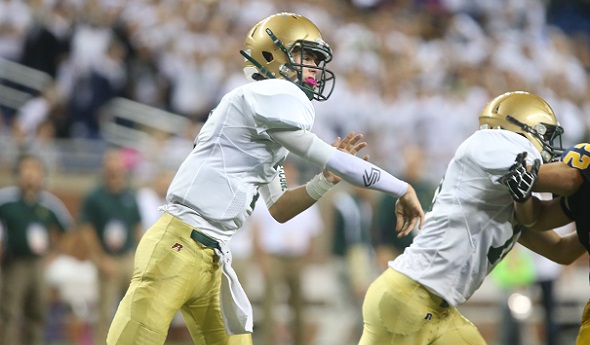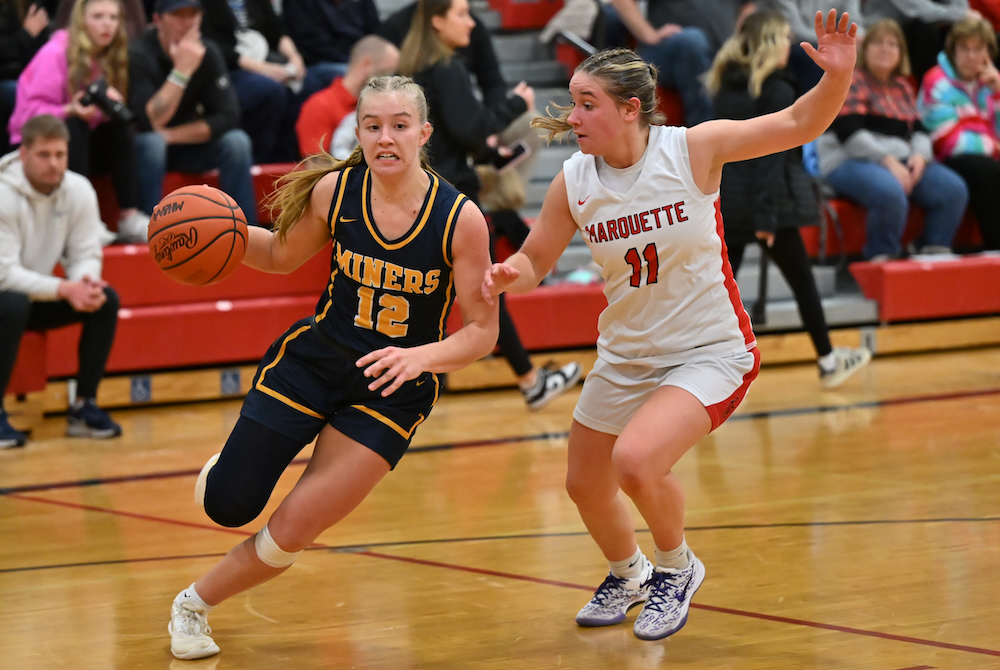
Special Year Thanks to No Specialization
August 7, 2015
By Geoff Kimmerly
Second Half editor
As we embark on another sports-filled school year Monday, we can look to a recent Monroe St. Mary Catholic Central grad for the value of a school year filled with sports.
As specialization at the highs school level continues to be debated, Bryce Windham will start his college baseball career this fall at Division I Old Dominion University – after playing baseball but also football and basketball for the Falcons.
 The MHSAA has long advocated athletes taking on as many sports as they have interest instead of focusing on just one in pursuit of a college scholarship – a position that’s received plenty of public backing of late, be it from stars of the U.S. women’s soccer team after their World Cup championship run or former Lansing Waverly multi-sport athlete John Smoltz during his enshrinement in the Major League Baseball Hall of Fame.
The MHSAA has long advocated athletes taking on as many sports as they have interest instead of focusing on just one in pursuit of a college scholarship – a position that’s received plenty of public backing of late, be it from stars of the U.S. women’s soccer team after their World Cup championship run or former Lansing Waverly multi-sport athlete John Smoltz during his enshrinement in the Major League Baseball Hall of Fame.
Enter Windham – who easily could’ve been excused for focusing on baseball, or even basketball as his dad is the St. Mary’s varsity boys coach. Instead, Bryce quarterbacked the football team to last season’s Division 6 championship – breaking Ithaca’s national-best 69-game winning streak in the Final – before being named Class C Player of the Year by The Associated Press in basketball and earning a Most Valuable Player honor at the baseball state coaches association all-star game at Comerica Park this spring.
All three of Windham's teams reached at least the MHSAA Quarterfinals.
“His participation in football and basketball helped land a Division 1 baseball scholarship to Old Dominion. They were able to see his athleticism in basketball and toughness in football, and ODU’s coach loved it,” dad and hoops coach Randy Windham said.
“He probably would’ve given up football, and that ended up his greatest memory by winning a state championship.”
Click to read about Windham’s multitude of accomplishments as reported last month by the Monroe Evening News.
Honors Abound
National coaching honors were bestowed on a trio of Michigan coaches over the summer:
- Retired Trenton ice hockey coach Mike Turner – the winningest hockey coach in MHSAA history with a record of 629-126-52 from 1974-81 and then 1995-2014 – was named National Coach of the Year in Special Sports by the National High School Athletic Coaches Association. His teams won 11 MHSAA titles and finished runner-up four times. “I was there when the MHSAA added hockey as one of their sanctioned sports and crowned their first MHSAA state championships in 1975. At that time there were 60-70 high school teams participating, and now there are 170,” Turner said. “It has been great to be a part of the advancements made in the sport of high school hockey, with more teams participating, more player development, and more opportunities that exist for players after high school.”
- Traverse City Central boys track and field and cross country coach John Lober won his second national coaching honor of the 2014-15 school year, named the NHSACA Coach of the Year for track and field to go with a previous honor earned in January from the National Federation of State High School Associations. He has coached the Traverse City Central boys track and field team since 1977 and also the boys cross country team since 1989. His 1992 track team won the Class A championship, and he has coached 17 individual MHSAA Finals champions. He was inducted into the Michigan Interscholastic Track Coaches Association Hall of Fame in 2006.
- Ann Arbor Pioneer assistant girls swimming and diving coach Liz Hill was named the Assistant Coach of the Year for all girls sports by the NHSACA. Hill, a former All-American at the University of Michigan and standout sprinter at Pioneer, began assisting her husband Denny Hill in 1983 before becoming his fulltime assistant a few seasons later. Together they’ve led the Pioneers girls to 15 MHSAA team titles, the last two as co-head coaches.
Michigan Mourns
Fremont and the high school athletic community statewide mourned the death July 21 of longtime coach Rich Tompkins, who led Fremont’s boys cross country teams to six MHSAA cross country championships including three and a runner-up finish during his last decade of coaching before retiring in 1997.
The Muskegon Chronicle reported that his boys and girls cross country teams and boys track and field team combined for 45 league championships, with his boys cross country team winning 116 straight duals from 1977-88. Tompkins was executive director of the Michigan High School Coaches Association for more than a decade and served on its board for more than two decades.
Click to read more from the Chronicle on Tompkins’ legacy.
Officials in the News
The Monroe County Officials Association took to the county fair to encourage passers-by to “Be the Referee” – and received 47 sign-ups from people interested in the avocation. Visitors to an MCOA booth at the fair were told in some detail what is involved with being an MHSAA official, and those who then signed up to find out more about officiating football, basketball, baseball or softball (sports the MCOA trains for and schedules) will be invited to an orientation session where they will become eligible for one of 20 complimentary registration fees for this school year.
 The West Michigan Officials Association marked a decade of support at the start of this summer for the Visually Impaired Sports and Activity Day, sponsored by the Helen DeVos Children’s Foundation. The WMOA has contributed nearly $18,000 to the event over the last 10 years as well as taking part in the event, which includes a number of sports and other activities.
The West Michigan Officials Association marked a decade of support at the start of this summer for the Visually Impaired Sports and Activity Day, sponsored by the Helen DeVos Children’s Foundation. The WMOA has contributed nearly $18,000 to the event over the last 10 years as well as taking part in the event, which includes a number of sports and other activities.
The Saginaw Athletic Officials Association sent along this photo of five members who worked 2013-14 MHSAA Finals, from left: Mark Jarlock (baseball), Tom Behmlander (softball), Scott Helmka (football), Dale Brown (softball and football) and Mark Schoenow (football). The Baseball Final was Jarlock’s first; the other officials had worked Finals in the past.
PHOTO: (Top) Monroe St. Mary quarterback Bryce Windham unloads a pass during last season's Division 6 Final win over Ithaca at Ford Field.

Breslin Bound: 2025-26 Girls Report Week 1
By
Geoff Kimmerly
MHSAA.com senior editor
December 15, 2025
We’re one week into the 2025-26 girls basketball season, and several annual contenders wasted little time seeing how they match up against each other – at least to start this winter.
Of course, there’s a long way to go before all is said and done. But there were plenty of solid statements, with more opportunities to shake things up as we settle into holiday break this weekend.
“Breslin Bound” is powered by MI Student Aid and based on results and schedules posted for each school at MHSAA.com.
Week in Review
The countdown of last week’s five most intriguing results:
1. Howell 41, Detroit Edison 26 The Highlanders (3-0) closed an impressive first week by downing Edison (2-1) at the Best of Michigan Holiday Classic at Belleville.
2. Frankenmuth 48, Portland 46 These two have played a series of stunners over the last two seasons, as Portland (1-1) won last year’s regular-season meeting by one and Frankenmuth (2-0) avenged in a Division 2 Regional Final.
3. Bath 71, Fowler 41 The Bees (3-0) avenged last season losses by nine and 34 to the Eagles (0-2), the reigning Division 4 champions.
4. Wayne Memorial 55, Detroit Renaissance 33 Wayne (2-0) won this rematch of a Division 1 Regional Final from last season, also won by the Zebras, at the Best of Michigan Tournament at Detroit Mercy.
5. Jackson Lumen Christi 50, Michigan Center 28 The Titans (2-0) opened in a big way in a matchup of teams that both won 19 games last winter.
Watch List
With an eye toward March, here are two teams in each division making sparks:
DIVISION 1
Plymouth (3-0) After back-to-back six-win finishes earlier this decade, Plymouth improved to 14 victories two seasons ago and 15-8 last winter. The Wildcats could be ready to take another step after opening this season with a 30-point win over Flat Rock, a 17-pointer over Dearborn Heights Crestwood and a 19-point victory over Brownstown Woodhaven. They’ll have a chance to avenge last season’s first defeat, to Berkley, when they meet Friday.
Rochester Hills Stoney Creek (3-0) Last year’s solid 16-8 run started with a loss to Walled Lake Northern, but Stoney Creek got off to a better start this time with a 35-32 victory over Northern last week. The Cougars followed with 41-32 victories over both White Lake Lakeland and Rochester Adams, and they could get another good gauge on their early-season progress when they host Goodrich on Wednesday.
DIVISION 2
Ionia (2-0) The opening week gave the Bulldogs a spark, and they’ll have an even bigger opportunity this week. Ionia started with a 51-44 win over St. Johns – avenging a loss from a year ago – before defeating Lake Odessa Lakewood. But these next few days could be telling, as Ionia hosts Eaton Rapids on Tuesday after tying the Greyhounds for second in the Capital Area Activities Conference White last winter. On Friday, Ionia travels to face reigning champion Portland, which also ended the Bulldogs season in March.
Kalkaska (2-0) Last week was one of the most successful for the Blazers in some time as they opened with a 33-32 overtime victory over Mancelona, then edged Benzie Central 26-23. Kalkaska finished 3-19 last season – and had won a combined five games over the last four. The Blazers will play in this weekend’s Elk Rapids Invitational to finish up a memorable December.
DIVISION 3
Lawton (2-0) A 50-45 win over South Haven and 53-30 victory over Constantine got the Blue Devils moving in the right direction again as they look to build on last winter’s 15-6 finish and third place in the Southwestern Athletic Conference Valley. Next up is Kalamazoo Hackett Catholic Prep – which finished second in the Valley last season, defeating Lawton twice – before the Blue Devils close 2025 with Watervliet at the Bangor Holiday Shootout.
Tawas (3-0) Tawas has jumped from four, to eight, to 13 wins over the last three seasons, and could be in for an exciting run given its success during the first week. A 44-32 win over Houghton Lake avenged a 30-point loss from last season, a 36-32 victory over Au Gres-Sims avenged a 20-point defeat from February, and a 27-16 win over Alpena came after 20 and 25-point losses to the Wildcats last winter.
DIVISION 4
Auburn Hills Oakland Christian (3-0) The Lancers have won 14 or 15 games three times this decade, including in going 15-9 a year ago, and they are well on their way to approaching those totals again. Oakland Christian hung on for a 32-26 win over Bloomfield Hills Academy of the Sacred Heart, but defeated Pontiac and Brighton Charyl Stockwell Academy by much more comfortable margins.
Reading (3-0) The Rangers finished fifth in the Big 8 Conference last season, but then won a pair of close matchups to claim a District title and advanced all the way to the Regional Finals. They earned double-digit wins over Camden-Frontier, Colon and Litchfield to kick off this campaign last week, and Tuesday’s matchup with reigning Big 8 co-champion Bronson could tell a lot.
Can’t-Miss Contests
Be on the lookout for results of these games coming up:
Friday – Rockford (2-0) vs. Howell (3-0) at Cornerstone University – These two are in a high-powered Cornerstone Invitational bracket with DeWitt and Coldwater.
Friday – Concord (0-1) at Bronson (0-1) – This pair shared the Big 8 Conference title last season after splitting their regular-season series.
Saturday – Tecumseh (3-0) at Detroit Edison (2-1) – The 2023 Division 2 champion Pioneers – semifinalists last year – host the reigning title winner at their Pioneer Classic.
Dec. 29 – Pewamo-Westphalia (2-0) at Flint Powers Catholic (1-0) – P-W won last year’s matchup 53-50 on the way to finishing 25-1, while Powers went enjoyed an 18-6 run.
Jan. 3 – Tecumseh (3-0) at Grand Rapids West Catholic (2-1) – Tecumseh definitely isn’t taking it easy over break, with this a rematch of last winter’s Division 2 Final.
MHSAA.com's weekly “Breslin Bound” reports are powered by MI Student Aid, a division within the Department of Lifelong Education, Advancement, and Potential (MiLEAP). MI Student Aid encourages students to pursue postsecondary education by providing access to student financial resources and information. MI Student Aid administers the state’s scholarship and grant programs that help make college Accessible, Affordable and Attainable for you. Click to connect with MI Student Aid and find more information on Facebook and X @mistudentaid.
PHOTO Negaunee's Gretel Johnson drives to the net while being defended by Lexi Curran during the Miners' 43-26 win over Marquette on Dec. 9. (Photo by Cara Kamps.)


